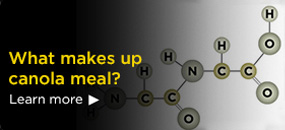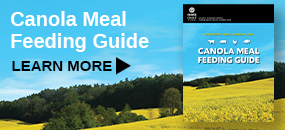

June 2014
We’re not speaking Greek! In situ is a valuable method of nutrition research, and we’d like to explain what it is and how it works. An in situ test helps us to understand what happens to feed ingredients in the rumen of dairy cows, as opposed to how the feed ingredient interacts with the whole cow.
Here’s how it works. Samples of feed are placed in a bag made of nylon or similar material. The bag has pores sufficiently large enough to allow rumen microbes to enter, but small enough to retain the feed particles. The bag is then placed in the rumen of a fistulated cow where is remains for a period of time. For overall digestion, most labs then wait 240 hours before removing the nylon bag. After the bag is removed, the amount that remains in the bag is considered to be indigestible in the rumen.
The test provides a significant amount of information about how and how much of an ingredient is digested. If an ingredient such as canola meal is left in the rumen for an extended period of time, the residue in the bag can be analyzed for protein or neutral detergent fiber (NDF) to assess how much of the sample is indigestible. In the case of NDF, it is not likely to be further digested by the cow once the material leaves the rumen, as the microbes responsible for secreting cellulase only exist in the rumen. In the case of protein, the amount remaining is likely not going to be digested further in the rumen, but there is potential for further digestion by the acid in the abomasum and the intestinal enzymes than occurred in the rumen.
Another interesting application of an in situ test is that you can evaluate the residue in the bag at various time points that are considerably shorter. This allows nutritionists to determine the rate at which protein or NDF is broken down in the rumen. A slow rate of breakdown for NDF means that a lot will leave the rumen undigested, and will not be available to the cow. A slow rate for protein, on the other hand, generally means that more of the protein will escape the rumen, and contribute amino acids in the small intestine to support the cows’ needs.
An in situ test provides some excellent information about the feed ingredient that remains in the nylon bags, but it does not give us as much information about the material that left the bags. Proteins especially become more soluble as the chains of amino acids are reduced in size in response to microbial degradation. However, the soluble material may be used by the rumen microbes, or they leave undegraded with the liquid that moves through the rumen.
Alternative methods have been developed to determine the fate of material that becomes solubilized and leaves the nylon bag. This information is being given greater consideration in newer digestion models.


